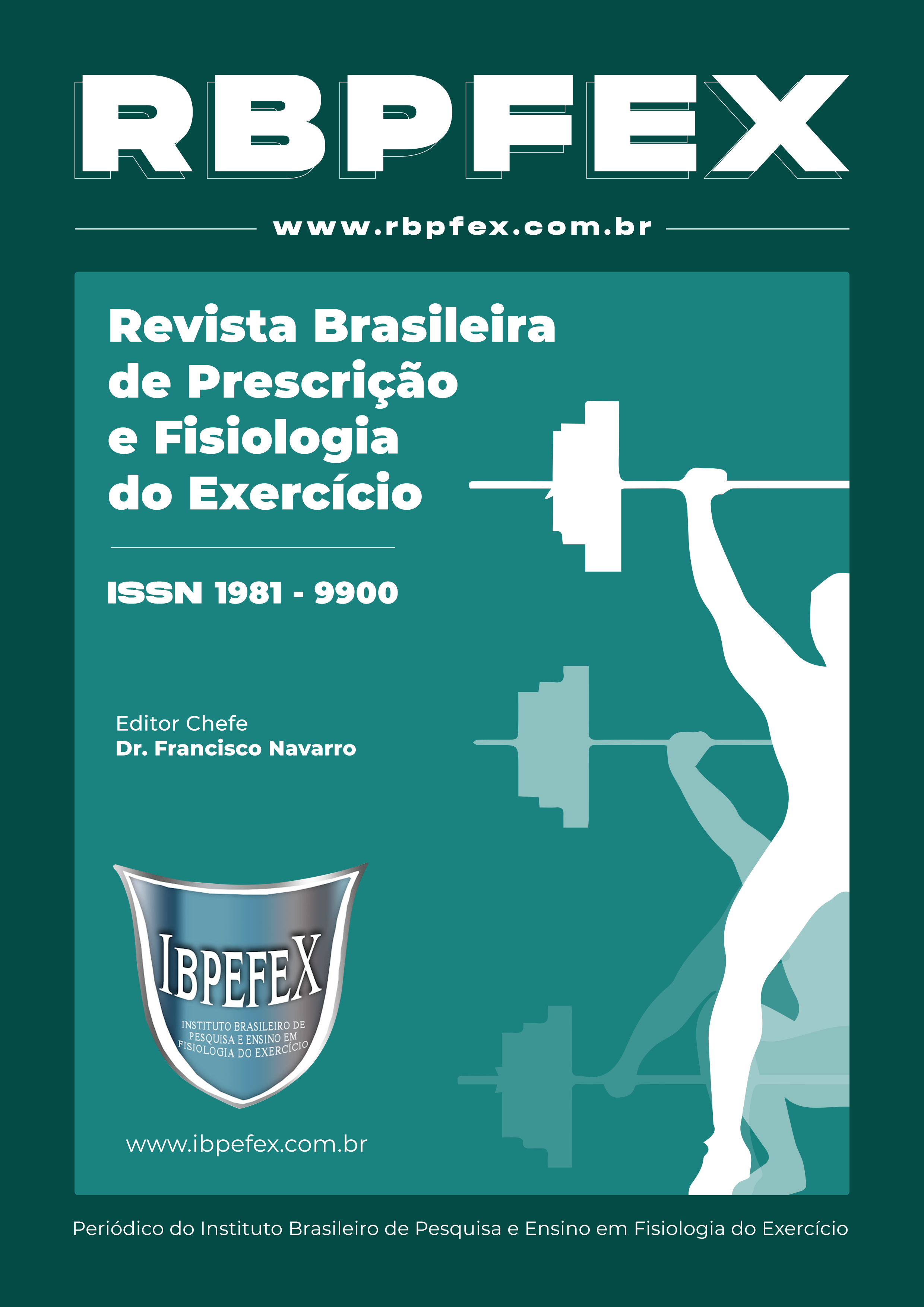The effects of high-intensity interval training in individuals with type 2 diabetes: a scope review
Abstract
Introduction: Type 2 Diabetes Mellitus (DM2) is associated with a sedentary lifestyle and leads to systemic responses that increase the risk of morbidity and mortality. High Intensity Interval Training (HIIT) demonstrates improved body composition, glycemic control and cardiorespiratory fitness. Objective: Map the effects of short-interval HIIT on DM2. Materials and Methods: This is a scoping review. As they were published in PubMed, Cochrane Library and Virtual Health Library (BVS) databases with the descriptors “Diabetes mellitus, type 2”, “Glycemic Control”, “High-Intensity interval training” between 03/24/2022 and 31 /03/2022. Eighty-seven articles were identified. After selection of studies and verification of eligibility, 10 articles remained. Additionally, summaries and abstracts were extracted using summary tables and narratives, including publication reviews evaluated using the PED scale, interventions and analyzes using the quality of the Consensus on Exercise Reporting Template (CERT) and the Grading of Recommendations. Assessment, Development and Evaluation (GRADE), respectively. Results: There was a reduction in body weight, body mass index, % body fat, fasting glucose and glycated hemoglobin and an increase in high-density lipoprotein (HDL) after the intervention. Similarly, positive results were found regarding the reduction of low-density lipoprotein (LDL), triglycerides, systolic blood pressure, markers of insulin resistance and medication use. Conclusion: Short-interval HIIT has potential effects for individuals with DM2, especially for metabolic, anthropometric and body composition variables. However, as this is a review with few studies included, caution should be exercised when using HIIT as a complement to treatment.
References
-Alvarez, C.; Ramirez-Campillo, R.; Martinez-Salazar, C.; Mancilla, R.; Flores-Opazo, M.; Cano-Montoya, J.; Ciolac, E.G. Low-Volume High-Intensity Interval Training as a Therapy for Type 2 Diabetes. Int J Sports Med. Bauru. Vol. 10. 2016.
-Costa, C. M. L. Tradução e adaptação da PEDro Scale para a cultura portuguesa: um instrumento de avaliação de ensaios clínicos em Fisioterapia. Universidade Técnica de Lisboa. Faculdade de Motricidade Humana. Lisboa. 2011
-Diretrizes Metodológicas - Sistema GRADE: manual de graduação da qualidade da evidência e força de recomendação para tomada de decisão em saúde. Ministério da Saúde. Brasília. 2014.
-Fraga, A. F.; Ladeia, A. M.T.; Couto de Sá, C. K.; Tenório, M. C. C. Efeito do exercício sobre níveis de HDL-C: uma revisão sistemática de metanálises. Rev Bras Med Esporte. Vol. 23. Núm. 6. 2017.
-Liu, J.; Zhu, L.; Li, P.; Li, N.; Xu, Y. Effectiveness of high-intensity interval training on glycemic control and cardiorespiratory fitness in patients with type 2 diabetes: a systematic review and meta-analysis. Aging Clinical and Experimental Research. Vol. 31. 2019. p. 575-593.
-Madsen, S. M.; Thorup, A. C. Overgaard, K. Jeppesen, P. B. High Intensity Interval Training Improves Glycaemic Control and Pancreatic β Cell Function of Type 2 Diabetes Patients. J. PLoS ONE. Vol. 8. 2015.
-Maldonado, A. J.; García-Suáreza, P. C.; Renteríaa, I.; Jiménezb, J. M.; Plaisancec, E. P. Molecular Basis of Disease. Ensenada Baja California. 2016.
-McKenzie, M. J.; Bossuyt, P. M.; Hoffmann, T. C.; Mulrow, C. D. The PRISMA 2020 statement: an updated guideline for reporting systematic reviews. BMJ. Vol. 372. Num. 21. 2020
-Mendes, R.; Souza, N.; Themudo-Barata, J. L.; Reis, V. M. High-Intensity Interval Training Versus Moderate-Intensity Continuous Training in Middle-Aged and Older Patients with Type 2 Diabetes: A Randomized Controlled Crossover Trial of the Acute E ects of Treadmill Walking on Glycemic Control. Int. J. Environ. Res. Public Health. Vol. 16. Num. 4163. 2019.
-Peters, M.D.J.; Godfrey, C.; McInerney, P.; Munn, Z.; Tricco, A.C.; Khalil, H. Chapter 11: Scoping Reviews (2020 version). In: Aromataris, E.; Munn, Z. (Editors). JBI Manual for Evidence Synthesis, JBI, 2020. Available from https://synthesismanual.jbi.global. https://doi.org/10.46658/JBIMES-20-12
-Price, J.K.; Gordon, B. A.; Bird, R. S.; Benson, C. A. Acute cardiovascular responses to interval exercise: A systematic review and meta-analysis. J. of Sports Science. 2021.
-Silva, R. P.; Benedet, J. Treinamento intervalado de alta intensidade e emagrecimento. TCC. Universidade do Sul de Santa Catarina. 2015.
-Slade, S. C. Dionne, C. E. Underwood, M. Buchbinder, R. Consensus on Exercise Reporting Template (CERT): Explanation and Elaboration Statement. J Sports Med. Vol. 50. 2016.
-Soares, B. A.; Souza, V. V.; Lage, V. K. S. High intensity interval training in the occurrence of injuries in runners: A literature review. Research Society and development. Vol. 10. Num. 5. 2021.
-Yan, H.; Prista, A.; Ranadive, S. M.; Damasceno, A.; Caupers, P.; Kanaley, J. A.; Fernhall, B. Effect of Aerobic Training on Glucose Control and Blood Pressure in T2DDM East African Males. ISRN Endocrinology. Champaign. 2014.
-Wu, Z. J.; Wang, Z. Y. Gao, H.E.; Zhou, X. F., Li, F. H. Impact of high-intensity interval training on cardiorespiratory fitness, body composition, physical fitness, and metabolic parameters in older adults: A meta-analysis of randomized controlled trials. Experimental Gerontology. Vol. 150. 2021.
Copyright (c) 2023 Iohana Schoder Bubolz, Thatiane Lopes Valentim Di Paschoale Ostolin

This work is licensed under a Creative Commons Attribution-NonCommercial 4.0 International License.
Authors who publish in this journal agree to the following terms:
- Authors retain the copyright and grant the journal the right of first publication, with work simultaneously licensed under the Creative Commons Attribution License BY-NC which allows the sharing of the work with acknowledgment of the authorship of the work and initial publication in this journal.
- Authors are authorized to enter into additional contracts separately for non-exclusive distribution of the version of the work published in this journal (eg, publishing in institutional repository or book chapter), with acknowledgment of authorship and initial publication in this journal.
- Authors are allowed and encouraged to post and distribute their work online (eg, in institutional repositories or on their personal page) at any point before or during the editorial process, as this can bring about productive change as well as increase impact and impact. citation of published work (See The Effect of Free Access).






